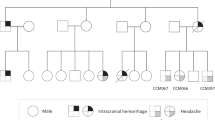Abstract
Loss of function mutations in CCM1/KRIT1, CCM2/MGC4607, and CCM3/PDCD10 gene are identified in about 95 % of familial cases of cerebral cavernous malformations and 2/3 of sporadic cases with multiple lesions. In this study, 279 consecutive index patients referred for either genetic counseling or for diagnosis of cerebral hemorrhage of unknown etiology were analyzed for the three cerebral cavernous malformations (CCM) genes by direct sequencing and quantitative studies, to characterize in more detail the mutation spectrum associated with cerebral cavernous malformations and to optimize CCM gene screening. Analysis of the cDNA was performed when possible to detect the consequences of the genomic variations. A pathogenic mutation was identified in 122 patients. CCM1 was mutated in 80 patients (65 %), CCM2 in 23 (19 %), and CCM3 in 19 (16 %). One hundred patients harbored a loss of function point mutation (82 %) and 22 had a large deletion (18 %). Novel unclassified variants were detected in the patients among whom six led to a splicing defect. The causality of three missense variants that did not modify the splicing could not be established. These findings expand the CCM mutation spectrum and highlight the importance of screening the three CCM genes with both direct sequencing and a quantitative method. In addition, six new unclassified variants were shown to be deleterious because they led to a splicing defect. This underlines the necessity of the cDNA analysis when an unknown variant is detected.


Similar content being viewed by others
References
Russell DS, Rubinstein LJ (1989) Pathology of tumors of the nervous system, 5th edn. Williams and Wilkins, Baltimore, pp 730–36
Rigamonti D, Hadley MN, Drayer BP, Johnson PC, Hoenig-Rigamonti K, Knight JT et al (1988) Cerebral cavernous malformations. Incidence and familial occurrence. N Engl J Med 319:343–347
Zabramski JM, Wascher TM, Spetzler RF, Johnson B, Golfinos J, Drayer BP et al (1994) The natural history of familial cavernous malformations: results of an ongoing study. J Neurosurg 80:422–432
Zabramski JM, Henn JS, Coons S (1999) Pathology of cerebral vascular malformations. Neurosurg Clin N Am 10:395–410
Laberge-le CS, Jung HH, Labauge P, Houtteville JP, Lescoat C, Cecillon M et al (1999) Truncating mutations in CCM1, encoding KRIT1, cause hereditary cavernous angiomas. Nat Genet 23:189–193
Sahoo T, Johnson EW, Thomas JW, Kuehl PM, Jones TL, Dokken CG et al (1999) Mutations in the gene encoding KRIT1, a Krev-1/rap1a binding protein, cause cerebral cavernous malformations (CCM1). Hum Mol Genet 8:2325–2333
Liquori CL, Berg MJ, Siegel AM, Huang E, Zawistowski JS, Stoffer T et al (2003) Mutations in a gene encoding a novel protein containing a phosphotyrosine-binding domain cause type 2 cerebral cavernous malformations. Am J Hum Genet 73:1459–1464
Denier C, Goutagny S, Labauge P, Krivosic V, Arnoult M, Cousin A et al (2004) Mutations within the MGC4607 gene cause cerebral cavernous malformations. Am J Hum Genet 74:326–337
Bergametti F, Denier C, Labauge P, Arnoult M, Boetto S, Clanet M et al (2005) Mutations within the programmed cell death 10 gene cause cerebral cavernous malformations. Am J Hum Genet 76:42–51
Denier C, Labauge P, Bergametti F, Marchelli F, Riant F, Arnoult M et al (2006) Genotype–phenotype correlations in cerebral cavernous malformations patients. Ann Neurol 60:550–556
Stahl S, Gaetzner S, Voss K, Brackertz B, Schleider E, Surucu O et al (2008) Novel CCM1, CCM2, and CCM3 mutations in patients with cerebral cavernous malformations: in-frame deletion in CCM2 prevents formation of a CCM1/CCM2/CCM3 protein complex. Hum Mutat 29:709–717
Gaetzner S, Stahl S, Surucu O, Schaafhausen A, Halliger-Keller B, Bertalanffy H et al (2007) CCM1 gene deletion identified by MLPA in cerebral cavernous malformation. Neurosurg Rev 30:155–159, discussion 159–60
Liquori CL, Berg MJ, Squitieri F, Leedom TP, Ptacek L, Johnson EW et al (2007) Deletions in CCM2 are a common cause of cerebral cavernous malformations. Am J Hum Genet 80:69–75
Liquori CL, Penco S, Gault J, Leedom TP, Tassi L, Esposito T et al (2008) Different spectra of genomic deletions within the CCM genes between Italian and American CCM patient cohorts. Neurogenetics 9:25–31
Felbor U, Gaetzner S, Verlaan DJ, Vijzelaar R, Rouleau GA, Siegel AM (2007) Large germline deletions and duplication in isolated cerebral cavernous malformation patients. Neurogenetics 8:149–153
D’Angelo R, Marini V, Rinaldi C, Origone P, Dorcaratto A, Avolio M et al (2011) Mutation analysis of CCM1, CCM2 and CCM3 genes in a cohort of italian patients with cerebral cavernous malformation. Brain Pathol 21:215–224
Casilli F, Di Rocco ZC, Gad S, Tournier I, Stoppa-Lyonnet D, Frebourg T et al (2002) Rapid detection of novel BRCA1 rearrangements in high-risk breast-ovarian cancer families using multiplex PCR of short fluorescent fragments. Hum Mutat 20:218–226
Saugier-Veber P, Goldenberg A, Drouin-Garraud V, de La Rochebrochard C, Layet V, Drouot N et al (2006) Simple detection of genomic microdeletions and microduplications using QMPSF in patients with idiopathic mental retardation. Eur J Hum Genet 14:1009–1017
Desmet FO, Hamroun D, Lalande M, Collod-Beroud G, Claustres M, Beroud C (2009) Human Splicing Finder: an online bioinformatics tool to predict splicing signals. Nucleic Acids Res 37:e67
Cave-Riant F, Denier C, Labauge P, Cecillon M, Maciazek J, Joutel A et al (2002) Spectrum and expression analysis of KRIT1 mutations in 121 consecutive and unrelated patients with cerebral cavernous malformations. Eur J Hum Genet 10:733–740
Gallione CJ, Solatycki A, Awad IA, Weber JL, Marchuk DA (2011) A founder mutation in the Ashkenazi Jewish population affecting messenger RNA splicing of the CCM2 gene causes cerebral cavernous malformations. Genet Med 13:662–666
Zawistowski JS, Stalheim L, Uhlik MT, Abell AN, Ancrile BB, Johnson GL et al (2005) CCM1 and CCM2 protein interactions in cell signaling: implications for cerebral cavernous malformations pathogenesis. Hum Mol Genet 14:2521–2531
Houdayer C, Caux-Moncoutier V, Krieger S, Barrois M, Bonnet F, Bourdon V et al (2012) Guidelines for splicing analysis in molecular diagnosis derived from a set of 327 combined in silico/in vitro studies on BRCA1 and BRCA2 variants. Hum Mutat 33:1228–1238
Verlaan DJ, Siegel AM, Rouleau GA (2002) Krit1 missense mutations lead to splicing errors in cerebral cavernous malformation. Am J Hum Genet 70:1564–1567
Gault J, Sain S, Hu LJ, Awad IA (2006) Spectrum of genotype and clinical manifestations in cerebral cavernous malformations. Neurosurgery 59:1278–1284, discussion 1284–5
Tonelli A, Lanfranconi S, Bersano A, Corti S, Bassi MT, Bresolin N (2009) Aberrant splicing due to a silent nucleotide change in CCM2 gene in a family with cerebral cavernous malformation. Clin Genet 75:494–497
Acknowledgments
We thank the patients and the clinicians who referred the patients: K. Abel Lablanche, Y. Benkaci, S. Berroir, J.Y. Bignon, P. Bitoun, M.P. Brechard, B. Bussel, F. Cartault, JF. Cassarini, H. Chabriat, S. Chapuis, M. Clanet, P. Corcia, C. Coubes, F. Darcel, A. David, C. de la Rochebrochard, I. Delalande, X. Deplanque, L. Derex, I. Desguerre, O. Detante, F. Di Rocco, A. Dieux, B. Doray, V. Drouin-Garraud, C. Férec, H. Flodrops, C. Francannet, , E. Ginglinger, I. Gobron, O. Godefroy, B. Godet, C. Goizet, V. Golfier., L. Guyant Marechal, D. Hervé, M. Holder Espinasse, H. Hosseini, E. Jeandidier, P. Labauge, A. Landais, C. Laroche, B. Leheup, P. Lejeune, G. Lesca, D. Leys, C. Marescaux, D. Martin Coignard, S. Mercier, J.M. Mussini, G. Nadeau, J.P. Neau, S. Odent, E. Ollagnon, P. Parent, G. Plessis, S. Puget, G. Ruvanot, D. Saibi, C. Sainte Rose, C. Scherer-Gagou, I. Sibon, S. Sigaudy, S. Spagnolo, C. Stapf, C. Thauvin, A. Toutain, C. Verny, J. Vigneron, M. Voicu, F. Voimant, and M. Zerah.
Author information
Authors and Affiliations
Corresponding author
Electronic supplementary material
Below is the link to the electronic supplementary material.
ESM Table 1
DOC 124 KB
ESM Table 2
DOC 86.0 KB
ESM Table 3
DOC 53.5 KB
Rights and permissions
About this article
Cite this article
Riant, F., Cecillon, M., Saugier-Veber, P. et al. CCM molecular screening in a diagnosis context: novel unclassified variants leading to abnormal splicing and importance of large deletions. Neurogenetics 14, 133–141 (2013). https://doi.org/10.1007/s10048-013-0362-0
Received:
Accepted:
Published:
Issue Date:
DOI: https://doi.org/10.1007/s10048-013-0362-0




